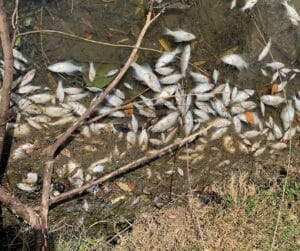
Turnover Related Fish Kill
Summer rain showers are considered a blessing here in north Texas. However, rapid pond turnovers caused by summer rain storms can be deadly to fish populations. This is a natural process that is most likely to occur after a pop-up storm preceded by a long period of heat and drought.
Deep Water Lacks Oxygen
Over the summer, the water column of a pond stratifies into different layers due to temperature gradients. The upper surface is heated by sunlight, making it less dense than the cooler water below. This upper layer is rich in plankton production and is where dissolved oxygen is concentrated. The water near the bottom is where organic decomposition occurs and is devoid of oxygen. The point of transition between the layers is known as the “thermocline”. These two layers typically do not mix until the surface water gradually cools in the fall. However, cool, heavy rain can cause non-typical turnovers.
Summer rain induced turnovers are caused by brief downpours that rapidly cool the pond surface. As the surface water begins to sink, it dilutes the available oxygen and disturbs decomposing organic matter at the pond bottom. When this happens the oxygen demand exceeds that needed for fish survival and they begin to die. Dead or dying fish will often be noticed the morning after the rainstorm.
Are All Ponds at Risk?
These types of catastrophic turnovers are most likely to occur in ponds 5 feet or deeper that do not have any type of supplemental aeration. Other influencing factors are overpopulations of fish, high sediment volumes, and nutrient polluted water. A sure sign of a pond turnover is if you notice a significant change in the water color. Typically, the water will turn from a clear or green tinted color to a dark coffee color. Offensive or septic odors are also commonly associated with pond turnovers.
How Do I Prevent Rapid Turnover?
The best insurance against rapid turnovers is bottom diffused aeration. These types of systems are designed to operate 24/7 during the warm months and are very effective at keeping the water column mixed at all times. It should be noted that decorative surface fountains do NOT prevent turnovers.
